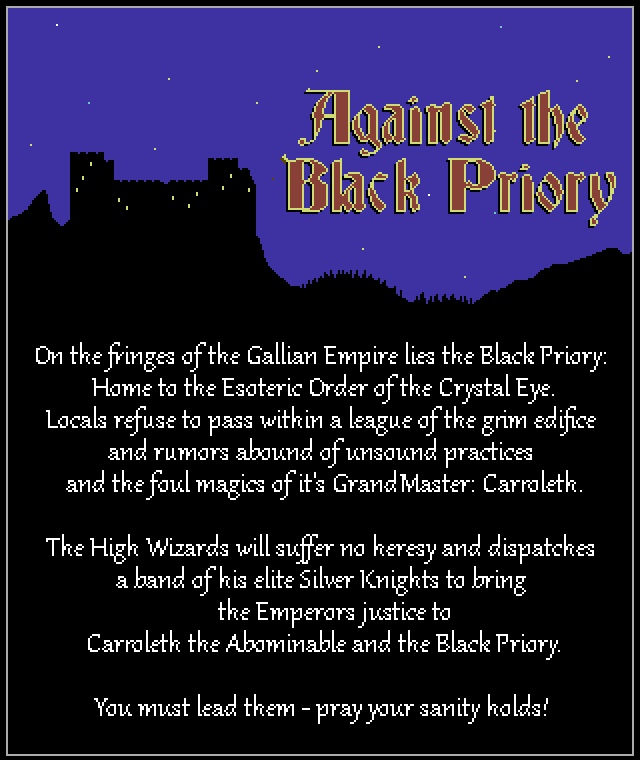The beta build (1.2.0) is up on itch.io for testers right now! SKALD has gotten a huge update to its combat system (as well as some new features) and I can’t wait for you to have a look at it!
The New Combat System
Combat is now resolved directly on the map itself. In other words, it no longer swaps to a separate combat map.

As I’ve been developing the game, one of the biggest shifts in my approach to designing SKALD, has been in level design: I originally saw exploration of the physical spaces of the game to be a distinct pillar of game-play alongside combat, character development and interaction.
However, as I’ve begun designing levels, it has occurred to me that interacting with the physicality of the world, could not be seen as a separate aspect of game-play: The physical layout of the game world is the canvas that encompasses all other aspects of the game and combat, dialogue and exploration is made more interesting by the fact that it takes place in a “physical” world with components that interact with, and affect each other.
Placing combat on the map itself was a natural consequence of this. This will make it possible to interact with terrain during combat, NPCs will join fights and destruction will linger after combat ends. You can approach enemies from different directions, become surrounded or attempt to use the terrain to your advantage.
Combat isn’t the only subsystem that is being adapted to this shift in design mentality. More on that down the line.

The combat system as it is in the coming update is still pretty bare-bones. It doesn’t really take advantage of it’s new form yet, but I need to get some play-testing done none the less: Both to weed out bugs and to get a basis for improving the system.
The main design principles for combat moving forward are:
- Combat should feel fast and smooth
- Combat should stay tactically interesting from early to late game
- Combat should be narratively expressive (e.i. it should serve as a tool for storytelling)
There’s also a number of issues I need to explore:
- How much information does the player need and how do I present it in the best way?
- What are the best controls for combat and what is the optimal relationship between keyboard and mouse input?
- How do I visualize all the different options players might have during combat in a good way?
- What types of terrain layout make for the most fun combat whilst avoiding overly dominant strategies (such as defending doorways)?
- What are some interesting combat-role archetypes for both enemies and PCs?
- How can feats and spells take optimal advantage of the combat system?
Other New Features and Updates
There is months of work in this update so changes are too numerous to mention in a lot of cases.
One of the more notable updates, however, is the ability to customize the character model (hair, colors, clothing etc). This adds a bit of flair for players but more importantly, it reduces the need for me to create custom models for NPCs! This is going to be a huge time-saver down the line as I can now swap around outfits to make an infinite amount of variations. Needless to say, there will be A LOT more customization options down the line. It also opens the door for stuff like faction-based outfits.

I’ve polished the input system a bit and vastly improved the path-finding AI so movement and controls should also feel quite a bit more snappy. Try to keep an eye on this and be sure to report any bugs related to movement, path-finding and input.
The Next Steps
For the next weeks I’m going to keep polishing the combat system whilst working towards the press-, and content-creator demo (which will of course be available for backers as well). It will contain new, unseen narrative content as well so it’ll be fun to see you guys dig into it.
There will probably be a couple more beta updates before the press demo is ready to drop so stay posted for that as well. I REALLY appreciate it if you take even 5 minutes to test the game and reporting any bugs or impressions afterwards: It really helps to make this the game we all want it to be!
In regards to the game being ready for early access in late 2020 – we’ll see. I’m truly working as fast as I can but it’s hard to predict the flow of the project. Rest assured however, that all the time is being spent make SKALD awesome and I can guarantee you it’s paying off!
Farewell!
I’ll keep you posted on updates as I go so be sure to check in wherever you follow me from time to time (Twitter or the SKALD Discord). You guys have been beyond supportive so far and I love being on this journey with you. All I can do is offer up a big heart-felt “thank you”.
Cheers,
AL





















